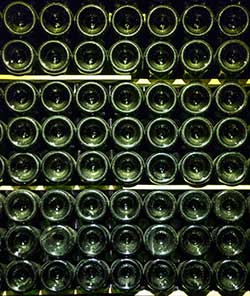
How is Champagne produced
A sparkling wine can only be called Champagne if it is produced in the Champagne region of Northern France. All Champagnes is made by the traditional method or ‘méthode champenoise’, as it is known in French. This method is also used for the production of other quality sparkling wines, including Cava. However, according to EU law, the name Champagne, and indeed ‘méthode champenoise’ can only be used for wine produced in the Champagne region.
Champagne is produced from 3 main grape varieties, Pinot Noir, Pinot Meunier and Chardonnay, from 3 main sub-regions of Champagne, and each add different characteristics to the wines.
Winemakers have to follow different steps to make Champagne:
1. Pressing
First, the grapes are pressed manually so that the juice, which will be turned into wine can be released gently, without the harsh tannins from the grape skins.
2. Fermentation
During the first fermentation process called the ‘alcoholic fermentation’, the juice is first chilled, thenfermented in tanks for around two weeks at a temperature of 18-20°C. The temperature and the yeasts that are naturally present , or have been added, acts on the sugars in the juice andtransforms the sugars into alcohol.
3. Clarification
All the yeast and solid particles which could affect the flavours of Champagne are removed. ( Change to – once the fermentation is complete, the wine is left to rest, so that all the dead yeasts and solid particles sink to the bottom of the stainless steel vats, and the liquid is then ‘racked’ off, which means that the deposits stay at the bottom and the wine is clear.)
4. Blending
This stage allows the winemaker to add its own ‘signature’ to the Champagne. Non-sparkling wines from different harvests - called ‘vin tranquille’ in French - are mixed together with sugars and yeasts to obtain a constant final flavour: this mixture is called ‘liqueur de tirage’. (Change to – At this stage the wines have been vinified individually by grape variety – because of the northerly location, the wines can be very high in acid and wouldn’t make a pleasant still wines. It is the blending and the magic that then occurs in the bottle that makes the wines unique, and special.
It is at this stage that the winemakers add their own special stamp, and create unique blends, or ‘cuvees’, depending on the style of the house brand, or the blend of the 3 varieties that they use, which will all add different characters.
Once the blend is finalised a small amount of ‘liqueur de tirage’ is added. This is a mix of wine, sugars and yeasts, which will be responsible for creating the famous bubbles. The bottles are then closed with a crown cork.
5. Bottling
The wine is then bottled and the second fermentation process can start. This is when the still wine turns into a sparkling wine. The sugars and yeasts act on the still wine, and produce carbon dioxide, which cannot escape from the bottle, and therefore dissolves into the wine, creating bubbles of trapped gas.
6. Rest
The Champagne bottles are then laid horizontally for a minimum of 12 months to make a non vintage Champagne or 24 months for a vintage. However after this time there is further ageing before release after the bottles have been disgorged and resealed for final release.
7. Riddling
During the resting period, every single bottle will be turned very slowly and very gently, generally by riddling machines, but in the case of premium champagnes, by hand, until they are upside down and all the deposits have dropped into the neck of the bottle. Riddling by hand is the most expensive way, and is performed by special trained people in the cellars, who can turn as many as 50,000 bottles in a single day!
8. Disgorging
The neck of the bottle is then plunged into a liquid of -25°C that freezes the deposits to ease their removal from the bottle. The crown corks are then removed by machine, to a constant sound of popping in the bottling hall. a blend of wine and sugar, or occasionally grape brandy is then added called ‘dosage’; it is the amount of sugar added at the end, which determines the final style of the wine, and whether it is labelled Brut, demi-sec, or doux.. The bottle is then ‘dressed’ up with its cork stopper, label, and foil.
The champagnes must then legally be held for a further period of time before they can be released for sale – in the case of non vintage, this is 3 months, although many houses will hold their stock for a minimum of a year. Vintage wines can be held for up to 10 years before release. It is this ageing period which will add character and depth to Champagne.
This process is more expensive than other techniques used for sparkling wines. This, together with the high cost of Champagne grapes, and the longer period of holding stock, are some of the reasons why Champagne prices are usually higher than other sparkling wines.
A final tip – if you can resist, try to keep any champagne you buy for a further few months, so that the flavours and complexity develop further. Non –vintage champagne will improve for about 2 years, whilst vintage champagne can easily be stored happily for a further 5 or more years.